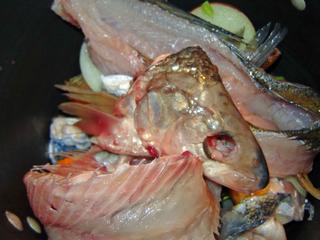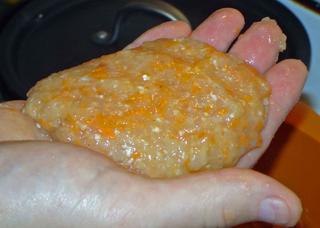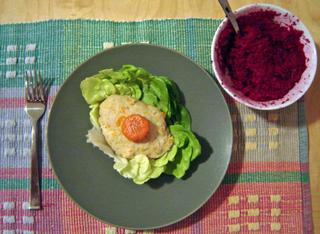Gefilte

First off, some Jewish holiday food/porn courtesy of Mr. Skin. (It's a Hannukah article, but it's fun to read all year long and not that dirty.)
Second off, some raw fish carcasses.

Gefilte is pronounced guh-FILL-ta. It means "stuffed." Cookbook authors tell us that the fish flesh, mixed with seasonings, eggs, and matzo meal, was originally stuffed back into its skin and cooked that way. Maybe I'll try that one of these days. Aside from some gefilte shaped into loaves I've never seen any that wasn't shaped into ovoid balls. Thus gefilte fish should really be called kugel fish, since kugel means ball. Don't try ordering that at the 2nd Ave. Deli.
To make this I called in the big guns: my mother, who remembers well her own mother making gefilte fish. She in turn called in her cousin Lorraine, who cooks from the same "recipes" as my grandmother and my great-great-grandmother in Poland, to whom all credit is ultimately due. For good measure I also called in fellow Torontonian-in-exile Mitchell Davis, author of The Mensch Chef: Or Why Delicious Jewish Food Isn't an Oxymoron, which is the only Jewish cookbook I need. Since I don't actually know him, I let his cookbook suffice.
Here's what you need to make gefilte fish:
-a large pot
-a kitchen with lots of windows
-freshwater fish: whitefish is a must, and it is traditionally mixed with some pike, carp, pickerel, perch, or other lake fish. It is not necessary to buy whole fish live and keep them in your bathtub for several days before preparing gefilte fish but it would make for a colorful anecdote.
-carrots, onions, celery, matzo meal, eggs, salt, sugar, and white pepper
Here's what you need to serve gefilte fish:
-a leaf of lettuce, which you will not eat
-sliced carrots, cooked to within an inch of their life
-prepared horseradish
I ordered a pound each of Walleye pike and whitefish to be ground by the fishmonger and asked for the carcasses and heads of two fish. My Bubbe insisted on the heads. I placed the bones and heads in my stockpot with some water, carrot, celery, onions, and white peppercorns and simmered this for an hour. The place smelled a bit fishy. I drained the fish stock and turned to the ground fish.
In the food processor, I whizzed a carrot and an onion to a pulp. I mixed this with the two pounds of fish, two beaten eggs (I left the shells out; my Bubbe sometimes included some by accident), about two tablespoons of matzo meal, about 1/4 cup cold water, and sugar, salt and white pepper to taste.
To taste, you ask? No, I didn't taste the raw fish. My uncle Arthur has a story. A relative of his (mother-in-law? aunt? grandmother?) used to taste the raw gefilte fish to season it and once became infected with an intestinal worm as a result. Arthur, at the time a very young doctor (in my family "uncle" and "doctor" are practically synonyms), extracted the worm through the poor woman's nose. I think Arthur was quite delighted by our family's disgusted reaction when he told that story a couple of years ago. Anyhow, fearing the parasite I cooked myself a little gefilte fish patty in a frying pan, tasted it, and then added more seasoning to the mix. I would guess I ended up using about 2 tsp salt, 1 tsp white pepper, and 1.5 tbs sugar. It could have been more aggressively seasoned and I will shoot for that next time.
I brought my strained stock to a simmer again and formed the gefilte balls in my wet hands. The hands must be kept wet. I let them roll gently out of my palm and into the water. (This is E's first photo on Haverchuk; my hands were too slimy to hold the camera.)

The fish simmered for about an hour and a half with some sliced carrots, which are an essential garnish. The other essential garnish is horseradish.
Now I might seem like the kind of guy who grates his own horseradish, but I don't care to. You see plenty of the ugly fresh ones in the stores this time of year and I have three reasons for eschewing them:
1. They cost $3 a pound and weight at least a pound apiece. Since I'm going to throw most of it away, that's a waste.
2. Grating the stuff yourself never produces the same thing as the prepared horseradish you buy in the little jars. I really love the taste of the stuff in the little jars. That's what I want on my gefilte fish.
3. I have always thought that raw horseradish looks like a large beast's penis, and this makes me feel extremely icky.
I did come up with an innovation, however, to the standard gefilte and horseradish combination. Instead of buying beet horseradish I decided to make my own. We had some beets I bought at a farmer's market and I simmered them until they were fully cooked, peeled two smallish ones, and tossed them in the food processor. I mixed this fine mince of beets with the prepared white horseradish and it was better than any other I have tasted. It was less sweet and more beety.
No Jewish feast is complete without gefilte fish served chilled as the first course. For dinner last night we made it the main course, accompanied by chopped liver spread on Tam Tam crackers and chicken soup with kreplach made of leftover pot roast, a bit of liver, and--this is really cheating--gyoza wrappers. It was a kind of Jewish tapas, and though there was plenty of food it didn't feel like a meal but like merely the beginning of one. Monday night, though, we'll have brisket and kugel and we'll have this gefilte fish as the starter. It will be just right.



2 Comments:
hey there! i just did a whole entry all about gefilte fish. just stumbled onto your blog by coincidence.
nice blog ;p -- shanah tovah! [2006]
/bb
Shana Tova! May the new year be one rich in gefilte fish!
Post a Comment
<< Home